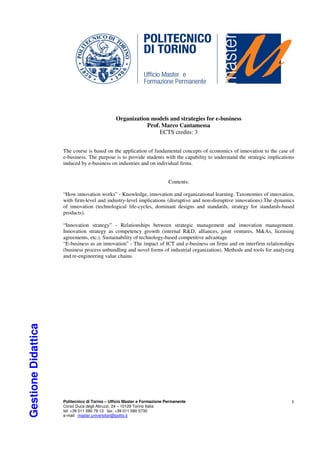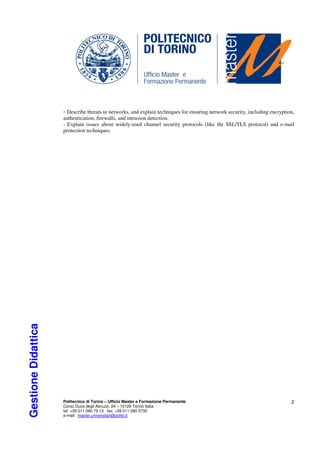Course overview
- 1. eGovernment & Auctions Online Prof. Enrico Ferro ECTS credits: 3 The course intends to provide a complete overview of the main aspects concerning the implementation of information and communication technologies in the public sector. The contents presented offer the opportunity to build a robust theoretical foundation as well as to acquire a set of useful analytical tools. At the end of the course, students will be able to understand and manage the intertwinement of technological, political and managerial aspects present in the implementation of eGovernment projects. Main topics covered in the course: 1. New Public Management and European Policy Framework 2. eGovernment Definition 3. Public eService Delivery and Digital Divide 4. Auction Theory and eProcurement 5. eDemocracy and eParticipation 6. Information Policy between markets and citizens’ rights Gestione Didattica Politecnico di Torino – Ufficio Master e Formazione Permanente 1 Corso Duca degli Abruzzi, 24 – 10129 Torino Italia tel: +39 011 090 79 13 fax: +39 011 090 5730 e-mail: [email protected]
- 2. Organization models and strategies for e-business Prof. Marco Cantamessa ECTS credits: 3 The course is based on the application of fundamental concepts of economics of innovation to the case of e-business. The purpose is to provide students with the capability to understand the strategic implications induced by e-business on industries and on individual firms. Contents: “How innovation works” - Knowledge, innovation and organizational learning. Taxonomies of innovation, with firm-level and industry-level implications (disruptive and non-disruptive innovations).The dynamics of innovation (technological life-cycles, dominant designs and standards, strategy for standards-based products). “Innovation strategy” - Relationships between strategic management and innovation management. Innovation strategy as competency growth (internal R&D, alliances, joint ventures, M&As, licensing agreements, etc.). Sustainability of technology-based competitive advantage “E-business as an innovation” - The impact of ICT and e-business on firms and on interfirm relationships (business process unbundling and novel forms of industrial organization). Methods and tools for analyzing and re-engineering value chains. Gestione Didattica Politecnico di Torino – Ufficio Master e Formazione Permanente 1 Corso Duca degli Abruzzi, 24 – 10129 Torino Italia tel: +39 011 090 79 13 fax: +39 011 090 5730 e-mail: [email protected]
- 3. Information systems for e-business Prof. Marco Torchiano ECTS credits: 3 Objectives To understand the advanced technologies behind modern information systems such as service oriented architecture, web services, COTS based systems. Enable the student to identify, evaluate, compare, and select the components for assembling and information system. Grading The course is based on a project conducted under the supervision of the teacher. The student will face a real-world case study and propose a suitable information system solution. A final oral exam will treat the topics presented during the course and their possible application to the case study. The project weights 80% of the final grade, the final exam 20%. Course topics • Role of IS and definitions • Required concepts of BPM and organization • Service Oriented Architectures • COTS based development • Examples of COTS Acquisition • IS architectures • Typical examples of architectures Gestione Didattica Politecnico di Torino – Ufficio Master e Formazione Permanente 1 Corso Duca degli Abruzzi, 24 – 10129 Torino Italia tel: +39 011 090 79 13 fax: +39 011 090 5730 e-mail: [email protected]
- 4. Computer systems security Prof. Diana Gratiela Berbecaru ECTS credits: 3 The goal of Computer systems security is to familiarize students with the security issues and technologies involved in modern information systems, including computer systems and networks. The course introduces first the subject of security of networked information systems, the basic terms used in this field and the main cryptographic techniques staying at the basic of many security protocols nowadays. Subsequently, students will gain an understanding of the various ways in which information systems can be attacked and tradeoffs in protecting systems and networks. This course requires at least user knowledge of computers and Internet. Students with technical knowledge of networks and network applications will perform some practical labs too. Topics: - security of ICT systems: technological attacks (eavesdropping, spoofing, modification, denial of service attacks ...) and non-technological attacks (social engineering); risk analysis. - base techniques for ICT system protection: basic cryptographic terms, symmetric and asymmetric encryption; integrity and authentication approaches; the public-key infrastructure (PKI) and digital certificates; - authentication systems: reusable and one-time passwords; symmetric and asymmetric challenge- response; hardware authenticators; the Kerberos system. - introduction to network security techniques: network access control (EAP, Radius); layer-3 security (IPsec); insecurity of IP, ICMP, DNS and routing; firewall (FW); intrusion detection systems (IDS). - security of Internet applications (principles): channel security (SSL, TLS); e-commerce security (SET, SSL for web-based transactions); e-mail security (spamming, PGP, S/MIME). By the end of this course, students will be able to: - State the basic concepts in information security, including security models, and security mechanisms, as Gestione Didattica well as requirements and techniques for security management, including security policies, risk analysis, and physical threats and controls. - Explain concepts related to applied cryptography, including plain-text, cipher-text, symmetric cryptography, asymmetric cryptography, digital signature, message authentication code, hash functions, and modes of encryption operations. - Explain the concepts of malicious code, including virus, Trojan horse, and worms. - Explain common vulnerabilities in computer programs, including buffer overflow vulnerabilities. - Outline the requirements and mechanisms for identification and authentication. - Explain issues about password authentication, including dictionary attacks (password guessing attacks), password management policies, and one-time password mechanisms. Politecnico di Torino – Ufficio Master e Formazione Permanente 1 Corso Duca degli Abruzzi, 24 – 10129 Torino Italia tel: +39 011 090 79 13 fax: +39 011 090 5730 e-mail: [email protected]
- 5. - Describe threats to networks, and explain techniques for ensuring network security, including encryption, authentication, firewalls, and intrusion detection. - Explain issues about widely-used channel security protocols (like the SSL/TLS protocol) and e-mail protection techniques. Gestione Didattica Politecnico di Torino – Ufficio Master e Formazione Permanente 2 Corso Duca degli Abruzzi, 24 – 10129 Torino Italia tel: +39 011 090 79 13 fax: +39 011 090 5730 e-mail: [email protected]





